Contract Law: Validity of Contract, Tort of Negligence, and Agency Law
VerifiedAdded on 2023/04/24
|7
|2436
|178
AI Summary
This document discusses the validity of a contract, tort of negligence, and agency law. It covers the necessary elements to form a valid contract, the principles of tort of negligence, and the relationship between principal and agent. It also applies these principles to a given scenario.
Contribute Materials
Your contribution can guide someone’s learning journey. Share your
documents today.
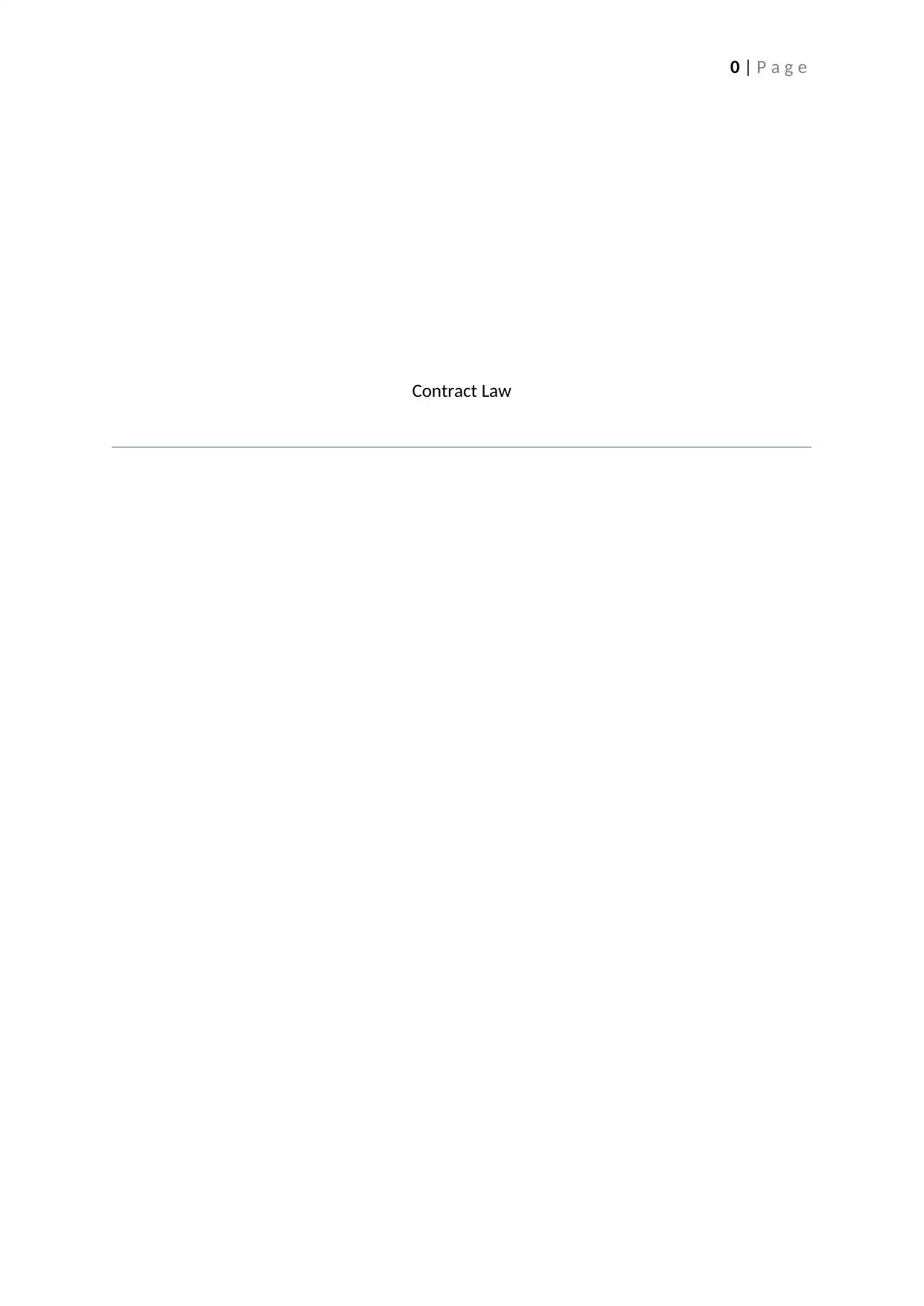
0 | P a g e
Contract Law
Contract Law
Secure Best Marks with AI Grader
Need help grading? Try our AI Grader for instant feedback on your assignments.
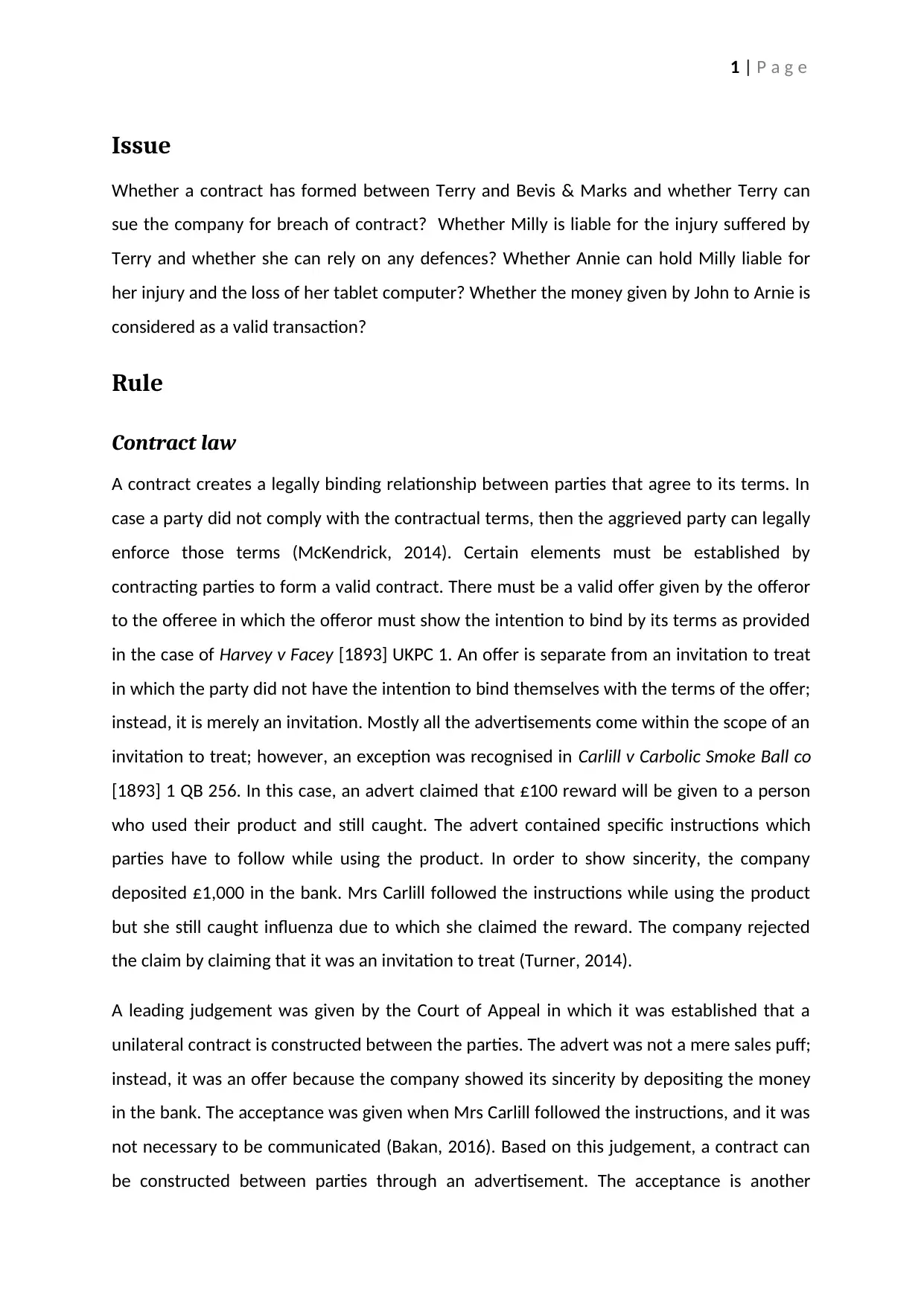
1 | P a g e
Issue
Whether a contract has formed between Terry and Bevis & Marks and whether Terry can
sue the company for breach of contract? Whether Milly is liable for the injury suffered by
Terry and whether she can rely on any defences? Whether Annie can hold Milly liable for
her injury and the loss of her tablet computer? Whether the money given by John to Arnie is
considered as a valid transaction?
Rule
Contract law
A contract creates a legally binding relationship between parties that agree to its terms. In
case a party did not comply with the contractual terms, then the aggrieved party can legally
enforce those terms (McKendrick, 2014). Certain elements must be established by
contracting parties to form a valid contract. There must be a valid offer given by the offeror
to the offeree in which the offeror must show the intention to bind by its terms as provided
in the case of Harvey v Facey [1893] UKPC 1. An offer is separate from an invitation to treat
in which the party did not have the intention to bind themselves with the terms of the offer;
instead, it is merely an invitation. Mostly all the advertisements come within the scope of an
invitation to treat; however, an exception was recognised in Carlill v Carbolic Smoke Ball co
[1893] 1 QB 256. In this case, an advert claimed that £100 reward will be given to a person
who used their product and still caught. The advert contained specific instructions which
parties have to follow while using the product. In order to show sincerity, the company
deposited £1,000 in the bank. Mrs Carlill followed the instructions while using the product
but she still caught influenza due to which she claimed the reward. The company rejected
the claim by claiming that it was an invitation to treat (Turner, 2014).
A leading judgement was given by the Court of Appeal in which it was established that a
unilateral contract is constructed between the parties. The advert was not a mere sales puff;
instead, it was an offer because the company showed its sincerity by depositing the money
in the bank. The acceptance was given when Mrs Carlill followed the instructions, and it was
not necessary to be communicated (Bakan, 2016). Based on this judgement, a contract can
be constructed between parties through an advertisement. The acceptance is another
Issue
Whether a contract has formed between Terry and Bevis & Marks and whether Terry can
sue the company for breach of contract? Whether Milly is liable for the injury suffered by
Terry and whether she can rely on any defences? Whether Annie can hold Milly liable for
her injury and the loss of her tablet computer? Whether the money given by John to Arnie is
considered as a valid transaction?
Rule
Contract law
A contract creates a legally binding relationship between parties that agree to its terms. In
case a party did not comply with the contractual terms, then the aggrieved party can legally
enforce those terms (McKendrick, 2014). Certain elements must be established by
contracting parties to form a valid contract. There must be a valid offer given by the offeror
to the offeree in which the offeror must show the intention to bind by its terms as provided
in the case of Harvey v Facey [1893] UKPC 1. An offer is separate from an invitation to treat
in which the party did not have the intention to bind themselves with the terms of the offer;
instead, it is merely an invitation. Mostly all the advertisements come within the scope of an
invitation to treat; however, an exception was recognised in Carlill v Carbolic Smoke Ball co
[1893] 1 QB 256. In this case, an advert claimed that £100 reward will be given to a person
who used their product and still caught. The advert contained specific instructions which
parties have to follow while using the product. In order to show sincerity, the company
deposited £1,000 in the bank. Mrs Carlill followed the instructions while using the product
but she still caught influenza due to which she claimed the reward. The company rejected
the claim by claiming that it was an invitation to treat (Turner, 2014).
A leading judgement was given by the Court of Appeal in which it was established that a
unilateral contract is constructed between the parties. The advert was not a mere sales puff;
instead, it was an offer because the company showed its sincerity by depositing the money
in the bank. The acceptance was given when Mrs Carlill followed the instructions, and it was
not necessary to be communicated (Bakan, 2016). Based on this judgement, a contract can
be constructed between parties through an advertisement. The acceptance is another
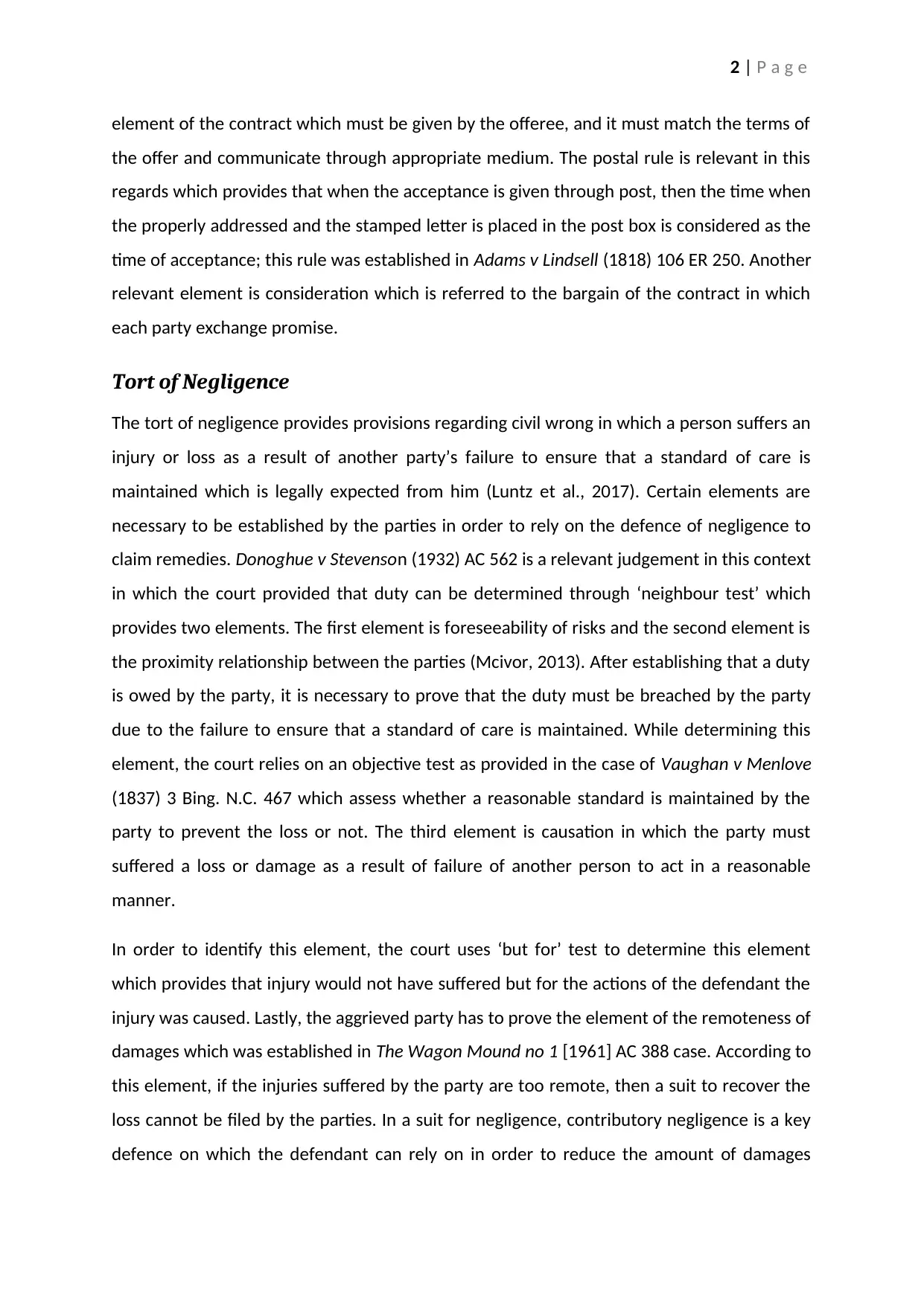
2 | P a g e
element of the contract which must be given by the offeree, and it must match the terms of
the offer and communicate through appropriate medium. The postal rule is relevant in this
regards which provides that when the acceptance is given through post, then the time when
the properly addressed and the stamped letter is placed in the post box is considered as the
time of acceptance; this rule was established in Adams v Lindsell (1818) 106 ER 250. Another
relevant element is consideration which is referred to the bargain of the contract in which
each party exchange promise.
Tort of Negligence
The tort of negligence provides provisions regarding civil wrong in which a person suffers an
injury or loss as a result of another party’s failure to ensure that a standard of care is
maintained which is legally expected from him (Luntz et al., 2017). Certain elements are
necessary to be established by the parties in order to rely on the defence of negligence to
claim remedies. Donoghue v Stevenson (1932) AC 562 is a relevant judgement in this context
in which the court provided that duty can be determined through ‘neighbour test’ which
provides two elements. The first element is foreseeability of risks and the second element is
the proximity relationship between the parties (Mcivor, 2013). After establishing that a duty
is owed by the party, it is necessary to prove that the duty must be breached by the party
due to the failure to ensure that a standard of care is maintained. While determining this
element, the court relies on an objective test as provided in the case of Vaughan v Menlove
(1837) 3 Bing. N.C. 467 which assess whether a reasonable standard is maintained by the
party to prevent the loss or not. The third element is causation in which the party must
suffered a loss or damage as a result of failure of another person to act in a reasonable
manner.
In order to identify this element, the court uses ‘but for’ test to determine this element
which provides that injury would not have suffered but for the actions of the defendant the
injury was caused. Lastly, the aggrieved party has to prove the element of the remoteness of
damages which was established in The Wagon Mound no 1 [1961] AC 388 case. According to
this element, if the injuries suffered by the party are too remote, then a suit to recover the
loss cannot be filed by the parties. In a suit for negligence, contributory negligence is a key
defence on which the defendant can rely on in order to reduce the amount of damages
element of the contract which must be given by the offeree, and it must match the terms of
the offer and communicate through appropriate medium. The postal rule is relevant in this
regards which provides that when the acceptance is given through post, then the time when
the properly addressed and the stamped letter is placed in the post box is considered as the
time of acceptance; this rule was established in Adams v Lindsell (1818) 106 ER 250. Another
relevant element is consideration which is referred to the bargain of the contract in which
each party exchange promise.
Tort of Negligence
The tort of negligence provides provisions regarding civil wrong in which a person suffers an
injury or loss as a result of another party’s failure to ensure that a standard of care is
maintained which is legally expected from him (Luntz et al., 2017). Certain elements are
necessary to be established by the parties in order to rely on the defence of negligence to
claim remedies. Donoghue v Stevenson (1932) AC 562 is a relevant judgement in this context
in which the court provided that duty can be determined through ‘neighbour test’ which
provides two elements. The first element is foreseeability of risks and the second element is
the proximity relationship between the parties (Mcivor, 2013). After establishing that a duty
is owed by the party, it is necessary to prove that the duty must be breached by the party
due to the failure to ensure that a standard of care is maintained. While determining this
element, the court relies on an objective test as provided in the case of Vaughan v Menlove
(1837) 3 Bing. N.C. 467 which assess whether a reasonable standard is maintained by the
party to prevent the loss or not. The third element is causation in which the party must
suffered a loss or damage as a result of failure of another person to act in a reasonable
manner.
In order to identify this element, the court uses ‘but for’ test to determine this element
which provides that injury would not have suffered but for the actions of the defendant the
injury was caused. Lastly, the aggrieved party has to prove the element of the remoteness of
damages which was established in The Wagon Mound no 1 [1961] AC 388 case. According to
this element, if the injuries suffered by the party are too remote, then a suit to recover the
loss cannot be filed by the parties. In a suit for negligence, contributory negligence is a key
defence on which the defendant can rely on in order to reduce the amount of damages
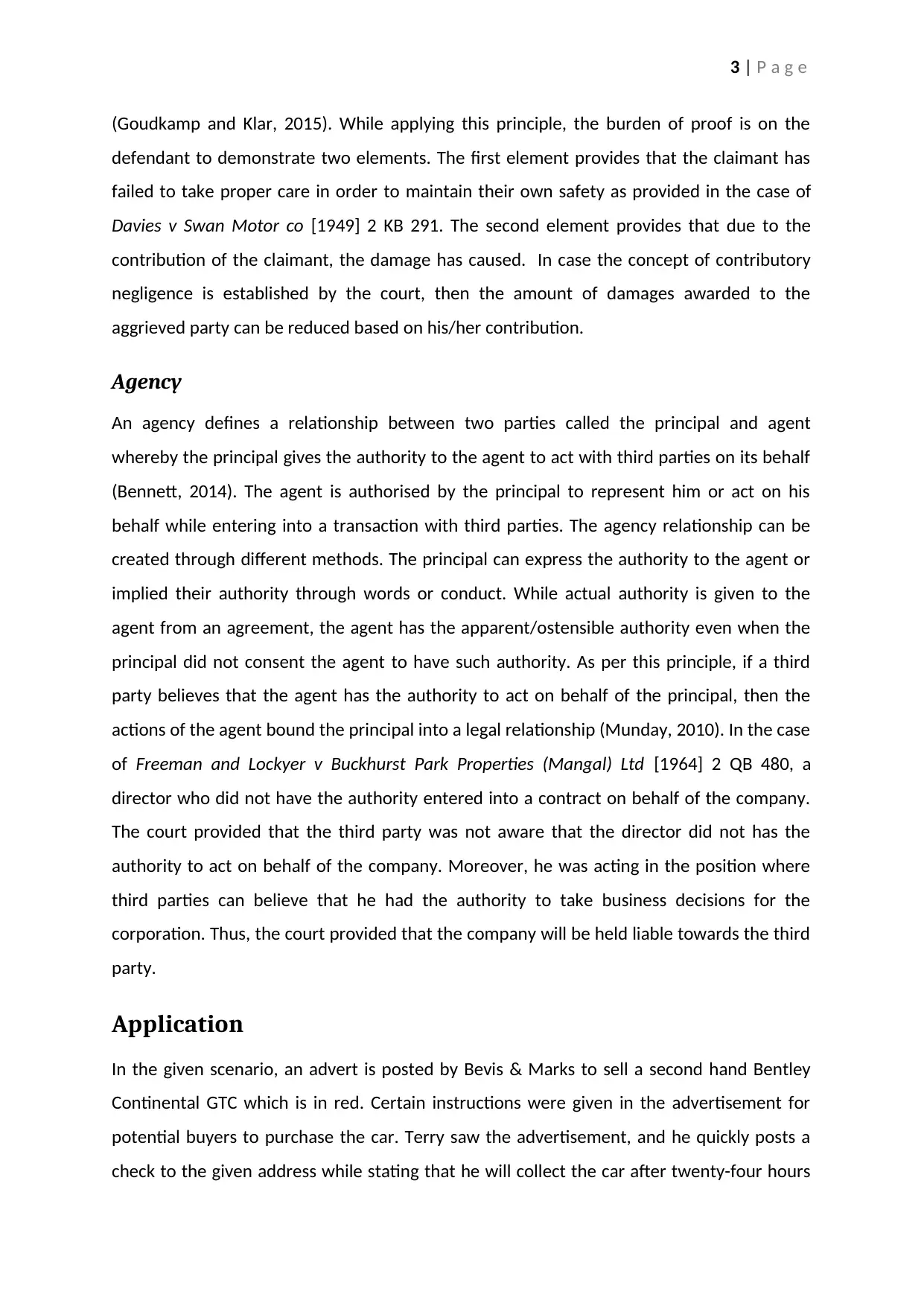
3 | P a g e
(Goudkamp and Klar, 2015). While applying this principle, the burden of proof is on the
defendant to demonstrate two elements. The first element provides that the claimant has
failed to take proper care in order to maintain their own safety as provided in the case of
Davies v Swan Motor co [1949] 2 KB 291. The second element provides that due to the
contribution of the claimant, the damage has caused. In case the concept of contributory
negligence is established by the court, then the amount of damages awarded to the
aggrieved party can be reduced based on his/her contribution.
Agency
An agency defines a relationship between two parties called the principal and agent
whereby the principal gives the authority to the agent to act with third parties on its behalf
(Bennett, 2014). The agent is authorised by the principal to represent him or act on his
behalf while entering into a transaction with third parties. The agency relationship can be
created through different methods. The principal can express the authority to the agent or
implied their authority through words or conduct. While actual authority is given to the
agent from an agreement, the agent has the apparent/ostensible authority even when the
principal did not consent the agent to have such authority. As per this principle, if a third
party believes that the agent has the authority to act on behalf of the principal, then the
actions of the agent bound the principal into a legal relationship (Munday, 2010). In the case
of Freeman and Lockyer v Buckhurst Park Properties (Mangal) Ltd [1964] 2 QB 480, a
director who did not have the authority entered into a contract on behalf of the company.
The court provided that the third party was not aware that the director did not has the
authority to act on behalf of the company. Moreover, he was acting in the position where
third parties can believe that he had the authority to take business decisions for the
corporation. Thus, the court provided that the company will be held liable towards the third
party.
Application
In the given scenario, an advert is posted by Bevis & Marks to sell a second hand Bentley
Continental GTC which is in red. Certain instructions were given in the advertisement for
potential buyers to purchase the car. Terry saw the advertisement, and he quickly posts a
check to the given address while stating that he will collect the car after twenty-four hours
(Goudkamp and Klar, 2015). While applying this principle, the burden of proof is on the
defendant to demonstrate two elements. The first element provides that the claimant has
failed to take proper care in order to maintain their own safety as provided in the case of
Davies v Swan Motor co [1949] 2 KB 291. The second element provides that due to the
contribution of the claimant, the damage has caused. In case the concept of contributory
negligence is established by the court, then the amount of damages awarded to the
aggrieved party can be reduced based on his/her contribution.
Agency
An agency defines a relationship between two parties called the principal and agent
whereby the principal gives the authority to the agent to act with third parties on its behalf
(Bennett, 2014). The agent is authorised by the principal to represent him or act on his
behalf while entering into a transaction with third parties. The agency relationship can be
created through different methods. The principal can express the authority to the agent or
implied their authority through words or conduct. While actual authority is given to the
agent from an agreement, the agent has the apparent/ostensible authority even when the
principal did not consent the agent to have such authority. As per this principle, if a third
party believes that the agent has the authority to act on behalf of the principal, then the
actions of the agent bound the principal into a legal relationship (Munday, 2010). In the case
of Freeman and Lockyer v Buckhurst Park Properties (Mangal) Ltd [1964] 2 QB 480, a
director who did not have the authority entered into a contract on behalf of the company.
The court provided that the third party was not aware that the director did not has the
authority to act on behalf of the company. Moreover, he was acting in the position where
third parties can believe that he had the authority to take business decisions for the
corporation. Thus, the court provided that the company will be held liable towards the third
party.
Application
In the given scenario, an advert is posted by Bevis & Marks to sell a second hand Bentley
Continental GTC which is in red. Certain instructions were given in the advertisement for
potential buyers to purchase the car. Terry saw the advertisement, and he quickly posts a
check to the given address while stating that he will collect the car after twenty-four hours
Secure Best Marks with AI Grader
Need help grading? Try our AI Grader for instant feedback on your assignments.
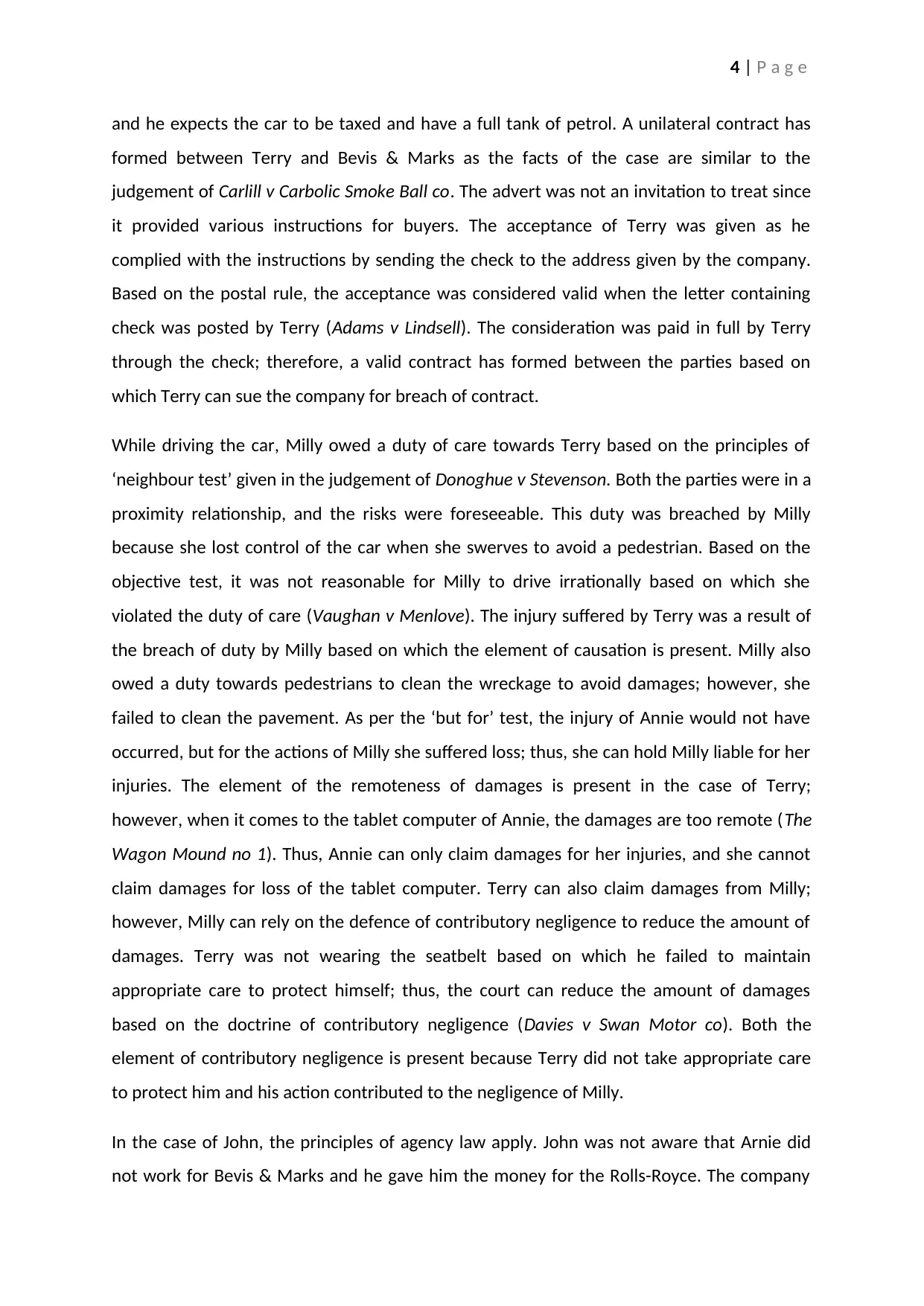
4 | P a g e
and he expects the car to be taxed and have a full tank of petrol. A unilateral contract has
formed between Terry and Bevis & Marks as the facts of the case are similar to the
judgement of Carlill v Carbolic Smoke Ball co. The advert was not an invitation to treat since
it provided various instructions for buyers. The acceptance of Terry was given as he
complied with the instructions by sending the check to the address given by the company.
Based on the postal rule, the acceptance was considered valid when the letter containing
check was posted by Terry (Adams v Lindsell). The consideration was paid in full by Terry
through the check; therefore, a valid contract has formed between the parties based on
which Terry can sue the company for breach of contract.
While driving the car, Milly owed a duty of care towards Terry based on the principles of
‘neighbour test’ given in the judgement of Donoghue v Stevenson. Both the parties were in a
proximity relationship, and the risks were foreseeable. This duty was breached by Milly
because she lost control of the car when she swerves to avoid a pedestrian. Based on the
objective test, it was not reasonable for Milly to drive irrationally based on which she
violated the duty of care (Vaughan v Menlove). The injury suffered by Terry was a result of
the breach of duty by Milly based on which the element of causation is present. Milly also
owed a duty towards pedestrians to clean the wreckage to avoid damages; however, she
failed to clean the pavement. As per the ‘but for’ test, the injury of Annie would not have
occurred, but for the actions of Milly she suffered loss; thus, she can hold Milly liable for her
injuries. The element of the remoteness of damages is present in the case of Terry;
however, when it comes to the tablet computer of Annie, the damages are too remote (The
Wagon Mound no 1). Thus, Annie can only claim damages for her injuries, and she cannot
claim damages for loss of the tablet computer. Terry can also claim damages from Milly;
however, Milly can rely on the defence of contributory negligence to reduce the amount of
damages. Terry was not wearing the seatbelt based on which he failed to maintain
appropriate care to protect himself; thus, the court can reduce the amount of damages
based on the doctrine of contributory negligence (Davies v Swan Motor co). Both the
element of contributory negligence is present because Terry did not take appropriate care
to protect him and his action contributed to the negligence of Milly.
In the case of John, the principles of agency law apply. John was not aware that Arnie did
not work for Bevis & Marks and he gave him the money for the Rolls-Royce. The company
and he expects the car to be taxed and have a full tank of petrol. A unilateral contract has
formed between Terry and Bevis & Marks as the facts of the case are similar to the
judgement of Carlill v Carbolic Smoke Ball co. The advert was not an invitation to treat since
it provided various instructions for buyers. The acceptance of Terry was given as he
complied with the instructions by sending the check to the address given by the company.
Based on the postal rule, the acceptance was considered valid when the letter containing
check was posted by Terry (Adams v Lindsell). The consideration was paid in full by Terry
through the check; therefore, a valid contract has formed between the parties based on
which Terry can sue the company for breach of contract.
While driving the car, Milly owed a duty of care towards Terry based on the principles of
‘neighbour test’ given in the judgement of Donoghue v Stevenson. Both the parties were in a
proximity relationship, and the risks were foreseeable. This duty was breached by Milly
because she lost control of the car when she swerves to avoid a pedestrian. Based on the
objective test, it was not reasonable for Milly to drive irrationally based on which she
violated the duty of care (Vaughan v Menlove). The injury suffered by Terry was a result of
the breach of duty by Milly based on which the element of causation is present. Milly also
owed a duty towards pedestrians to clean the wreckage to avoid damages; however, she
failed to clean the pavement. As per the ‘but for’ test, the injury of Annie would not have
occurred, but for the actions of Milly she suffered loss; thus, she can hold Milly liable for her
injuries. The element of the remoteness of damages is present in the case of Terry;
however, when it comes to the tablet computer of Annie, the damages are too remote (The
Wagon Mound no 1). Thus, Annie can only claim damages for her injuries, and she cannot
claim damages for loss of the tablet computer. Terry can also claim damages from Milly;
however, Milly can rely on the defence of contributory negligence to reduce the amount of
damages. Terry was not wearing the seatbelt based on which he failed to maintain
appropriate care to protect himself; thus, the court can reduce the amount of damages
based on the doctrine of contributory negligence (Davies v Swan Motor co). Both the
element of contributory negligence is present because Terry did not take appropriate care
to protect him and his action contributed to the negligence of Milly.
In the case of John, the principles of agency law apply. John was not aware that Arnie did
not work for Bevis & Marks and he gave him the money for the Rolls-Royce. The company
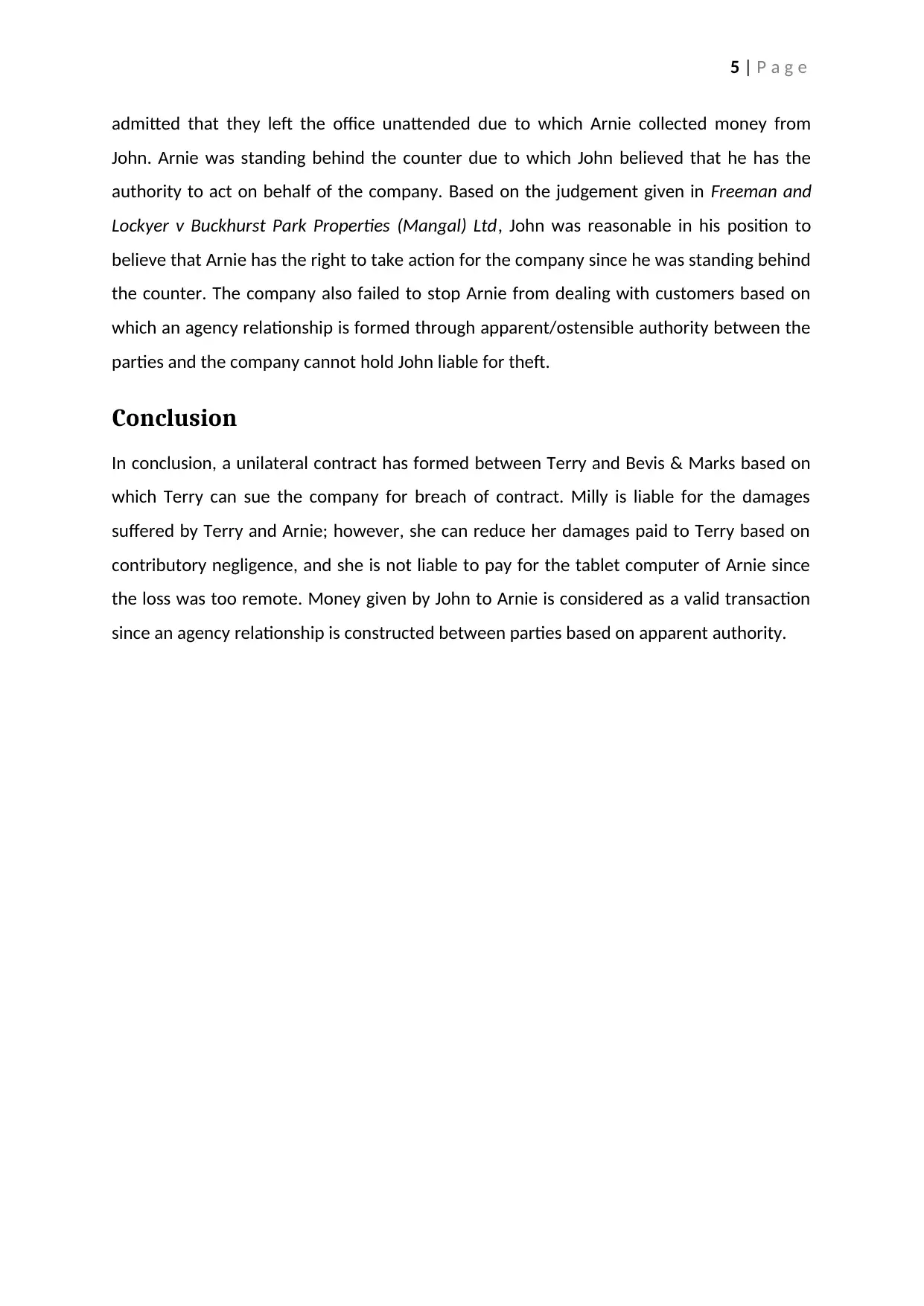
5 | P a g e
admitted that they left the office unattended due to which Arnie collected money from
John. Arnie was standing behind the counter due to which John believed that he has the
authority to act on behalf of the company. Based on the judgement given in Freeman and
Lockyer v Buckhurst Park Properties (Mangal) Ltd, John was reasonable in his position to
believe that Arnie has the right to take action for the company since he was standing behind
the counter. The company also failed to stop Arnie from dealing with customers based on
which an agency relationship is formed through apparent/ostensible authority between the
parties and the company cannot hold John liable for theft.
Conclusion
In conclusion, a unilateral contract has formed between Terry and Bevis & Marks based on
which Terry can sue the company for breach of contract. Milly is liable for the damages
suffered by Terry and Arnie; however, she can reduce her damages paid to Terry based on
contributory negligence, and she is not liable to pay for the tablet computer of Arnie since
the loss was too remote. Money given by John to Arnie is considered as a valid transaction
since an agency relationship is constructed between parties based on apparent authority.
admitted that they left the office unattended due to which Arnie collected money from
John. Arnie was standing behind the counter due to which John believed that he has the
authority to act on behalf of the company. Based on the judgement given in Freeman and
Lockyer v Buckhurst Park Properties (Mangal) Ltd, John was reasonable in his position to
believe that Arnie has the right to take action for the company since he was standing behind
the counter. The company also failed to stop Arnie from dealing with customers based on
which an agency relationship is formed through apparent/ostensible authority between the
parties and the company cannot hold John liable for theft.
Conclusion
In conclusion, a unilateral contract has formed between Terry and Bevis & Marks based on
which Terry can sue the company for breach of contract. Milly is liable for the damages
suffered by Terry and Arnie; however, she can reduce her damages paid to Terry based on
contributory negligence, and she is not liable to pay for the tablet computer of Arnie since
the loss was too remote. Money given by John to Arnie is considered as a valid transaction
since an agency relationship is constructed between parties based on apparent authority.
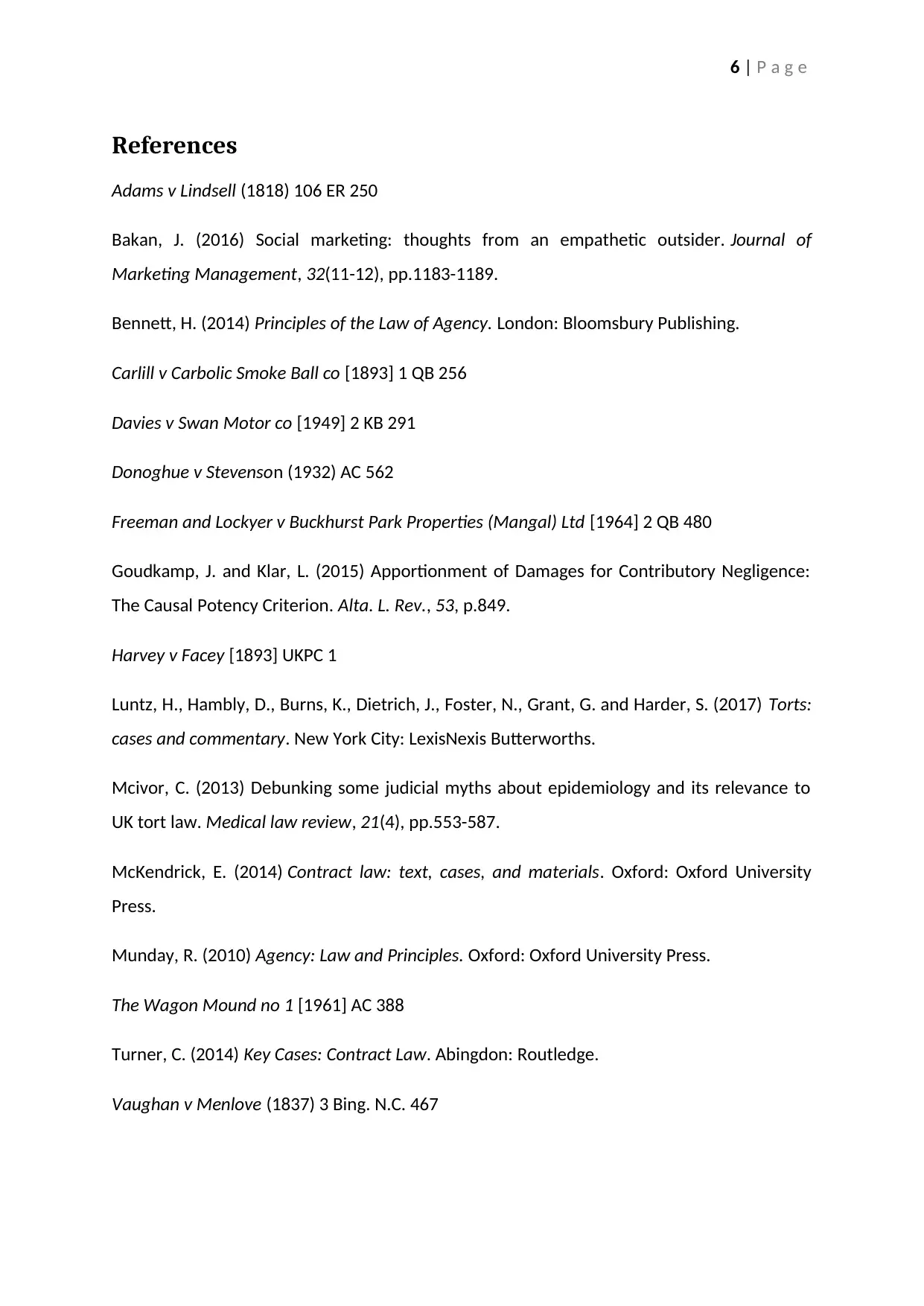
6 | P a g e
References
Adams v Lindsell (1818) 106 ER 250
Bakan, J. (2016) Social marketing: thoughts from an empathetic outsider. Journal of
Marketing Management, 32(11-12), pp.1183-1189.
Bennett, H. (2014) Principles of the Law of Agency. London: Bloomsbury Publishing.
Carlill v Carbolic Smoke Ball co [1893] 1 QB 256
Davies v Swan Motor co [1949] 2 KB 291
Donoghue v Stevenson (1932) AC 562
Freeman and Lockyer v Buckhurst Park Properties (Mangal) Ltd [1964] 2 QB 480
Goudkamp, J. and Klar, L. (2015) Apportionment of Damages for Contributory Negligence:
The Causal Potency Criterion. Alta. L. Rev., 53, p.849.
Harvey v Facey [1893] UKPC 1
Luntz, H., Hambly, D., Burns, K., Dietrich, J., Foster, N., Grant, G. and Harder, S. (2017) Torts:
cases and commentary. New York City: LexisNexis Butterworths.
Mcivor, C. (2013) Debunking some judicial myths about epidemiology and its relevance to
UK tort law. Medical law review, 21(4), pp.553-587.
McKendrick, E. (2014) Contract law: text, cases, and materials. Oxford: Oxford University
Press.
Munday, R. (2010) Agency: Law and Principles. Oxford: Oxford University Press.
The Wagon Mound no 1 [1961] AC 388
Turner, C. (2014) Key Cases: Contract Law. Abingdon: Routledge.
Vaughan v Menlove (1837) 3 Bing. N.C. 467
References
Adams v Lindsell (1818) 106 ER 250
Bakan, J. (2016) Social marketing: thoughts from an empathetic outsider. Journal of
Marketing Management, 32(11-12), pp.1183-1189.
Bennett, H. (2014) Principles of the Law of Agency. London: Bloomsbury Publishing.
Carlill v Carbolic Smoke Ball co [1893] 1 QB 256
Davies v Swan Motor co [1949] 2 KB 291
Donoghue v Stevenson (1932) AC 562
Freeman and Lockyer v Buckhurst Park Properties (Mangal) Ltd [1964] 2 QB 480
Goudkamp, J. and Klar, L. (2015) Apportionment of Damages for Contributory Negligence:
The Causal Potency Criterion. Alta. L. Rev., 53, p.849.
Harvey v Facey [1893] UKPC 1
Luntz, H., Hambly, D., Burns, K., Dietrich, J., Foster, N., Grant, G. and Harder, S. (2017) Torts:
cases and commentary. New York City: LexisNexis Butterworths.
Mcivor, C. (2013) Debunking some judicial myths about epidemiology and its relevance to
UK tort law. Medical law review, 21(4), pp.553-587.
McKendrick, E. (2014) Contract law: text, cases, and materials. Oxford: Oxford University
Press.
Munday, R. (2010) Agency: Law and Principles. Oxford: Oxford University Press.
The Wagon Mound no 1 [1961] AC 388
Turner, C. (2014) Key Cases: Contract Law. Abingdon: Routledge.
Vaughan v Menlove (1837) 3 Bing. N.C. 467
1 out of 7
Related Documents
Your All-in-One AI-Powered Toolkit for Academic Success.
+13062052269
info@desklib.com
Available 24*7 on WhatsApp / Email
![[object Object]](/_next/static/media/star-bottom.7253800d.svg)
Unlock your academic potential
© 2024 | Zucol Services PVT LTD | All rights reserved.





